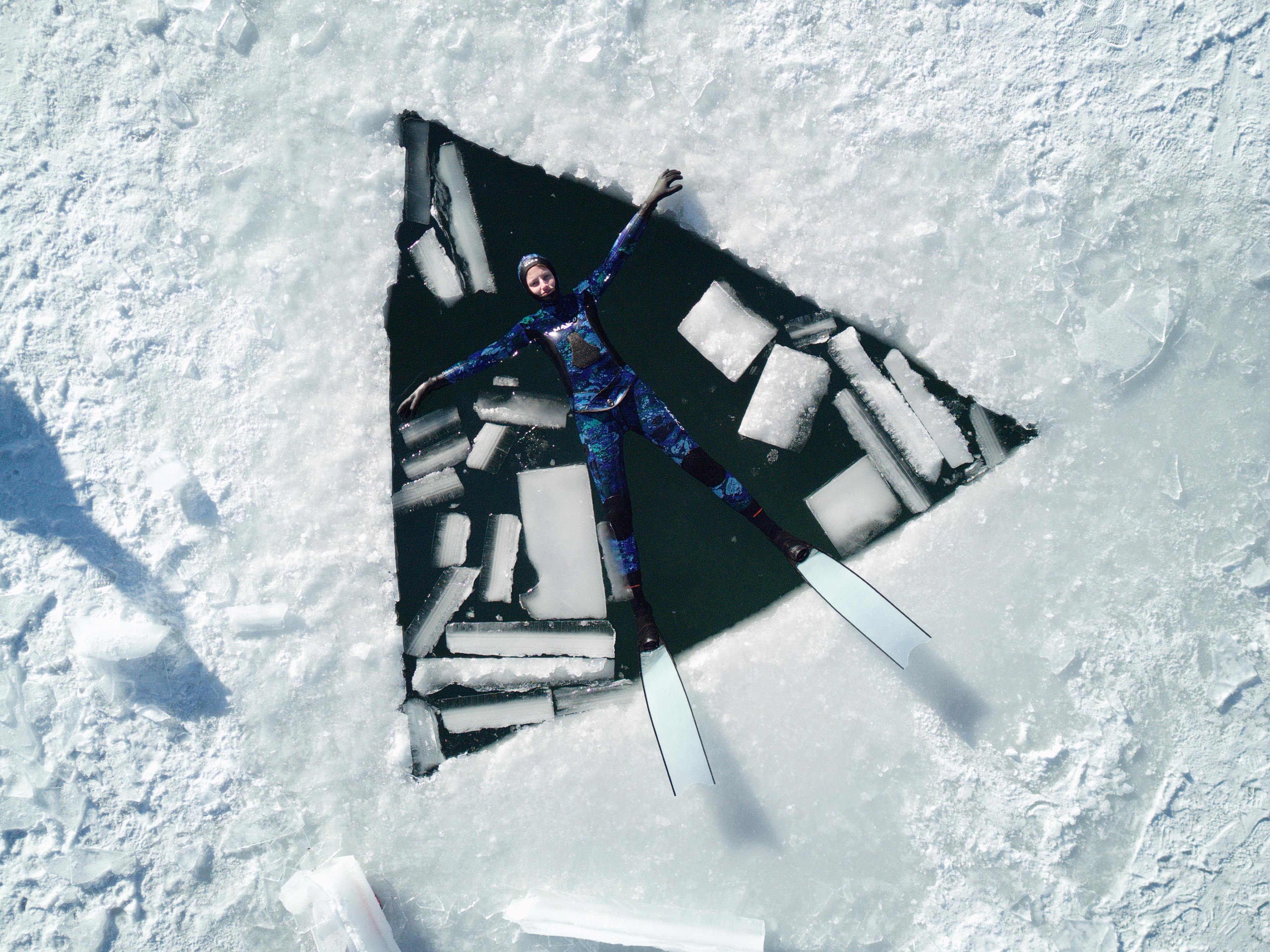
“Beauty is no quality in things themselves: It exists merely in the mind which contemplates them; and each mind perceives a different beauty.”
― David Hume, Of the Standard of Taste
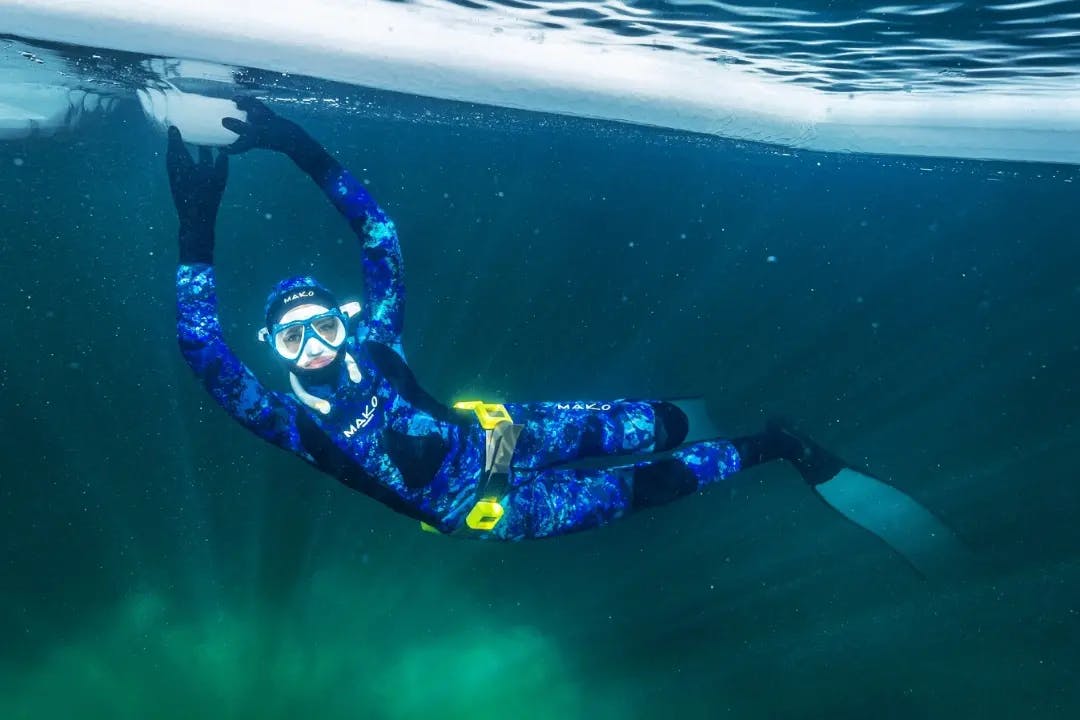

The winter conditions produced by a combination of snow, ice, temperature and light forms perfect conditions for the spectacular landscape over and under the lake surface.
Rime ice forms on cold mornings and nights when the atmosphere is calm. Water droplets freeze on the surface and during the crystallisation process to a needle-like crystal structure growing in different ways depending on wind direction.
In general, the frost forms at a temperature below 0°C, and the departure depends on the moisture in air.
Water vapour molecules contact a sub-freezing surface and bypass the moisture, forming fluffy, light, solid ice crystals on the surface, known as a Hoarfrost.
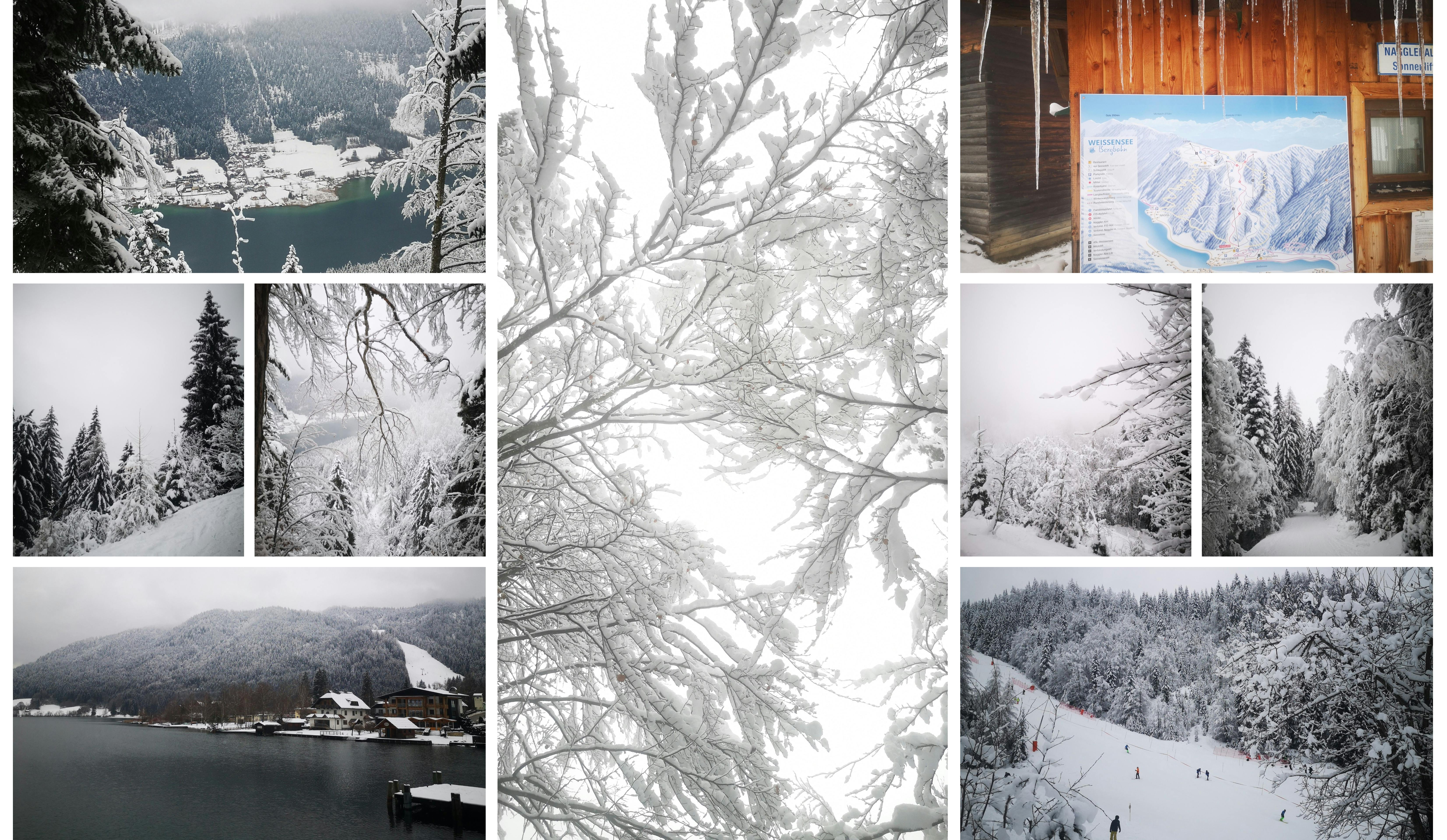
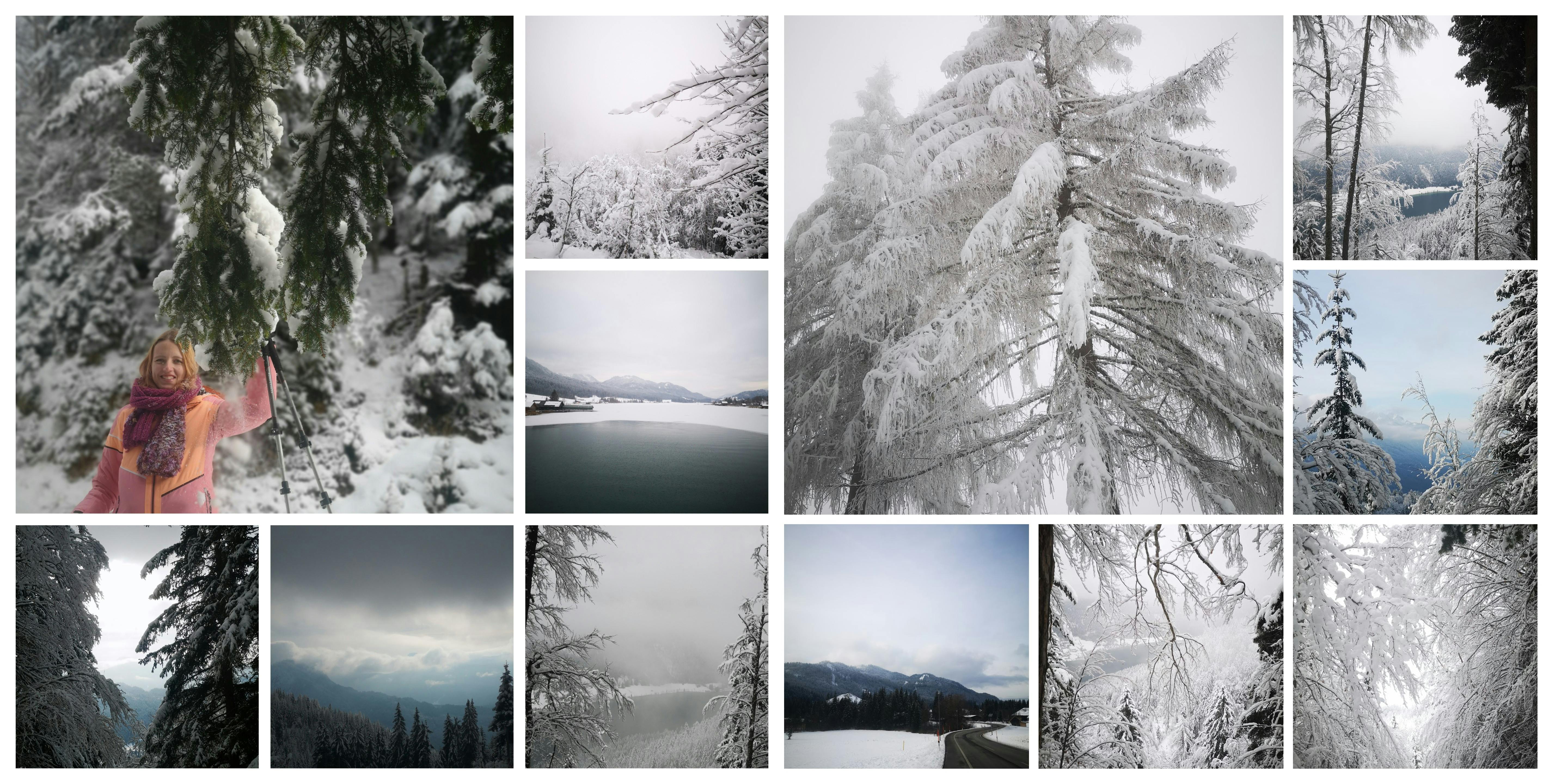
Soft rime results from the rapid freezing of very small supercooled water droplets in fog or cloud when they impact on prevalently vertical surfaces with temperature below 0°C. In this way, wind-borne droplets stick forming a dendritic accretion and trees are white on the side facing the wind, and iceless on the opposite side.
In the case that the concretion of ice has been generated by ice needles already present in the atmosphere, this phenomenon is known as advection hoar frost (or also ice fog, frozen fog, frost fog, air hoar, or rime fog). [1]
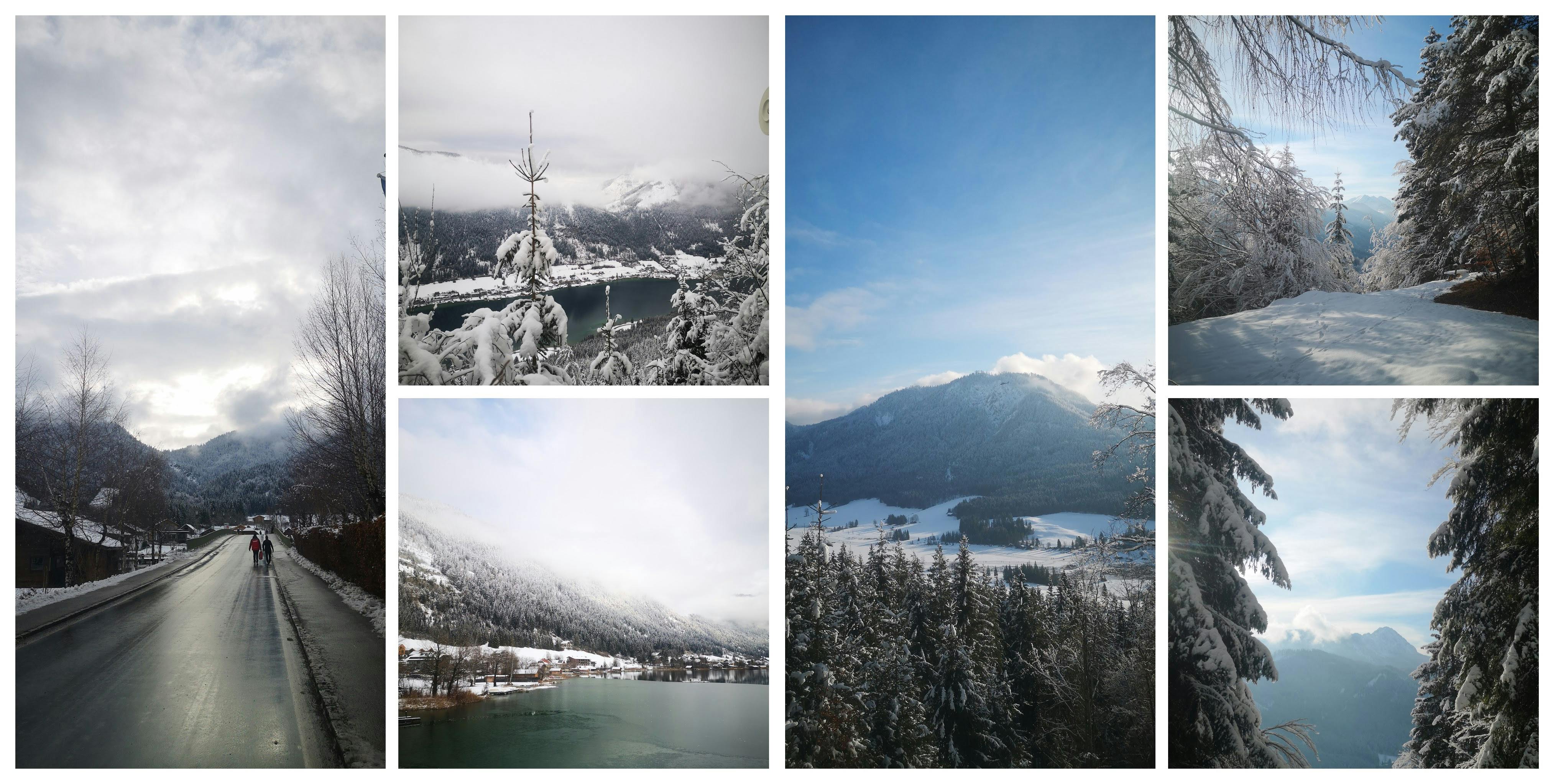
On the land and below the frozen open water, including snow cover, glaciers, ice sheets, ice shelves, icebergs, sea ice, lake ice, river ice, permafrost, and seasonally frozen ground, and solid precipitation.
During the day I couldn’t mistake the snowfall from the lake effect snowfall in the Weissensee “snowball”. The cold air moved over the warm lake water until the clouds increased for the snow heavy enough to fall. The environment around and under the frozen lake is still and slowed in motion.
 Photo: Micha Schramm and Nik Skrlec
Photo: Micha Schramm and Nik Skrlec
Levitating through silence in the midst of the nature and unknown, unreachable depths. There is no space for fears, panic or pain,- only calmness, joy and reflection to inner state and trust. A year ago I was only dreaming about freediving expeditions, inspired by the achievements of Johanna Nordblad and stories from Maik Priebe about freediving.
Freediving under the ice with Nik Linder
The freediving experience under the ice is so unique and powerful! You are in full control and trust reconnecting with yourself and your own mind and body- the cold exposure helps dealing with psychological and physical factors such as fear, panic and anxiety.
I felt incredibly stronger and balanced after freediving. I haven’t experienced it doing any other cardiovascular sports- it’s the power of ice diving!
Diving under the ice is an extreme sport, and is allowed only for advanced divers. The prior knowledge in both scuba diving and freediving gave me confidence and trust to dive under the ice for the first time. You should never dive alone or with an inexperienced diver, because at the end of the line your safety and your buddy watching you is responsible to support or do a rescue if something goes wrong. There is no room for mistakes.
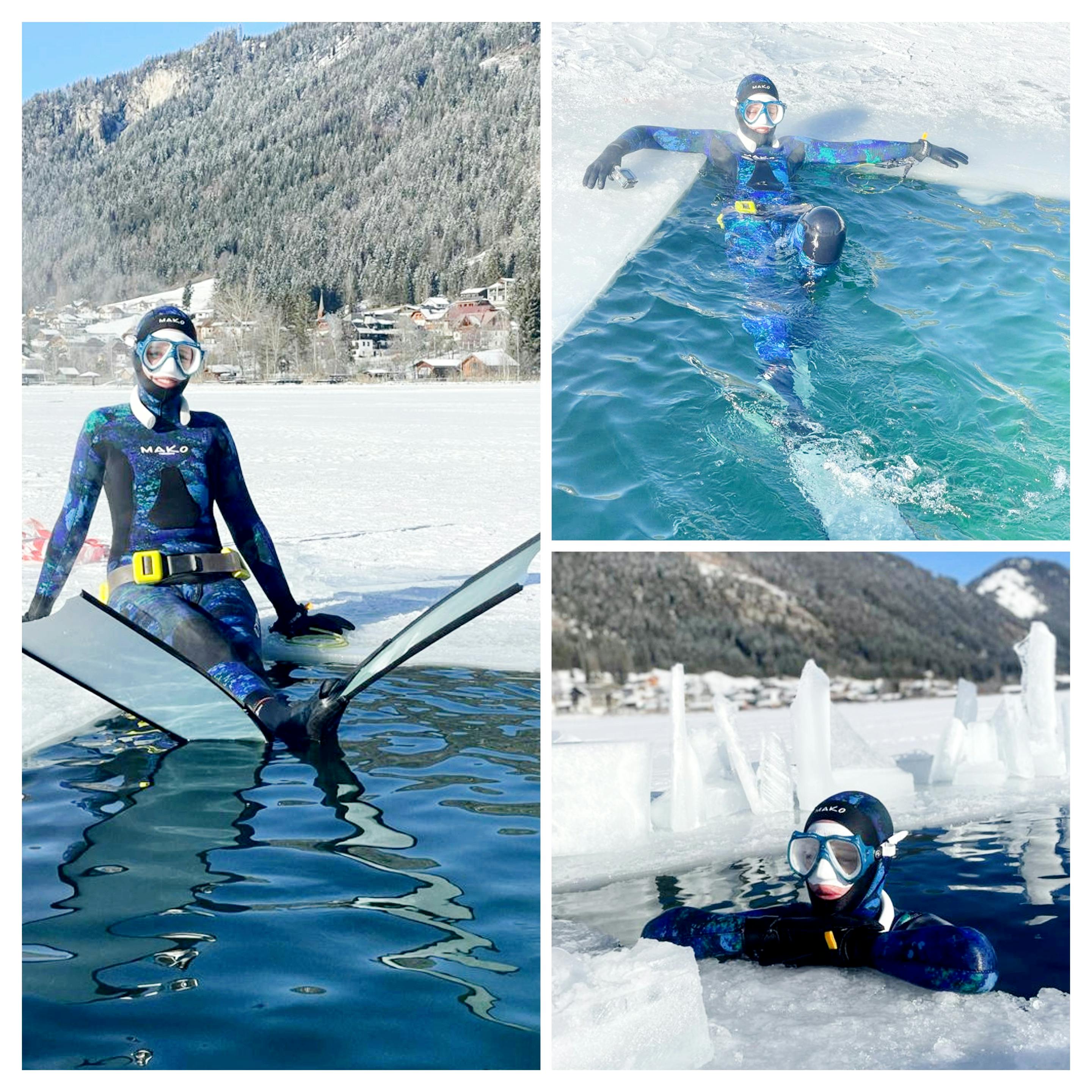
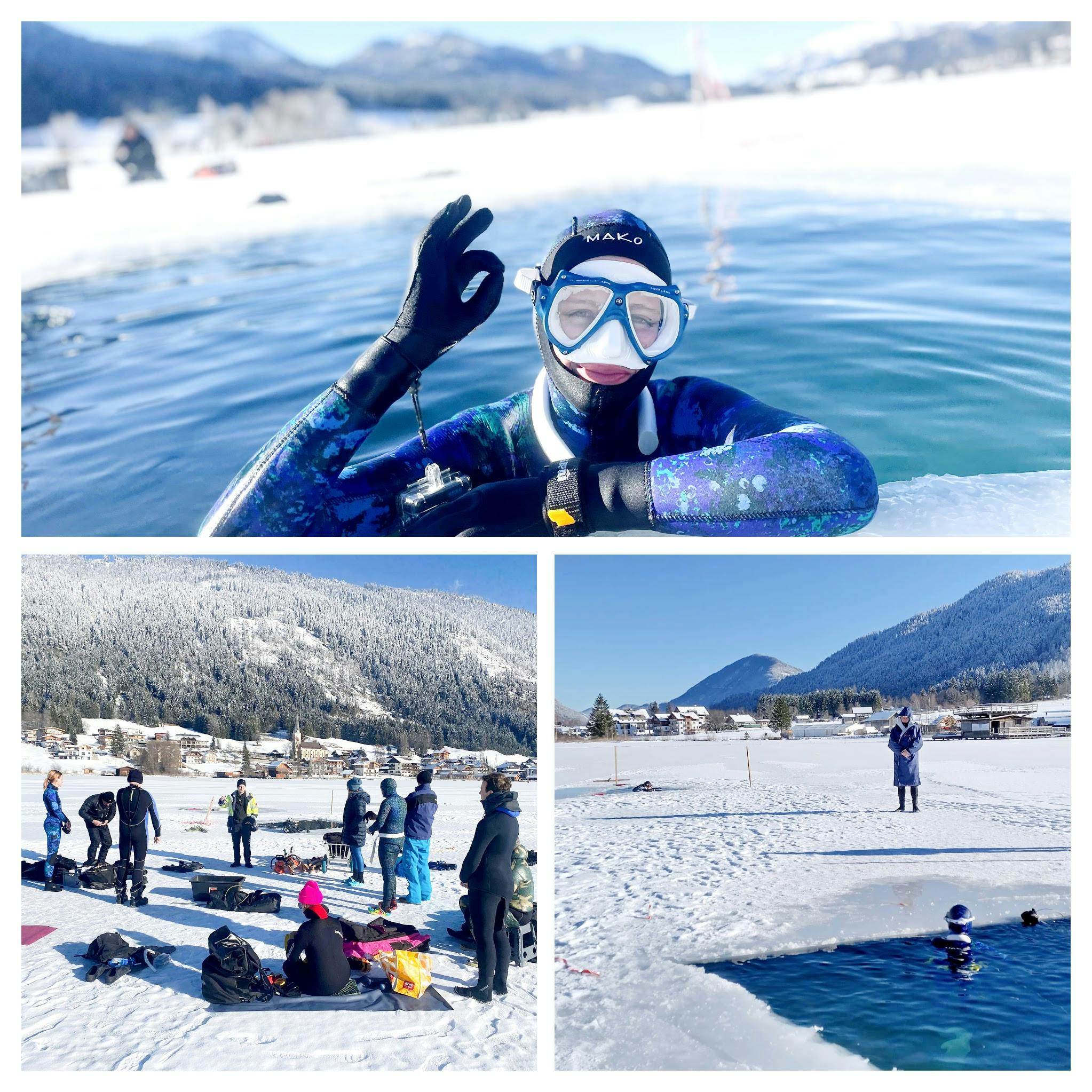
The freediving event was well organized by Nik Linder who has been freediving professionally for more than 20 years and holds world records in freediving and freediving under the ice disciplines. We were around seven divers in a group, with two coordinators including Nik, diving between 10am to 3pm.
Divers are equipped with warm clothes, thermos and neoprene. I had taken two pairs of dive gloves, blankets from the hotel, and a basket of nuts among other things, which can’t be an overestimate in extreme cold. I appreciate the small life hacks from other divers discovered in the previous years, such as pouring boiling water over the 5mm neoprene.
During the first days of diving we had experienced good weather and diving conditions. Linking unique enclave formation isolates the lake, in a forest or with vegetation closely surrounding, or growing into the tarn. Due to its steep shore, the eastern part of Weissensee is almost uninhabited. Along the shore are banks of chalk originating from the surrounding mountains of the Southern Limestone Alps, which give the waters its characteristic color and its name- Weissensee translating to “White Lake”.
We were accommodated at Kolbitsch hotel with breathtaking views over the lake. The hotel wasn’t overcrowded at the time and the restaurant, hot showers and sauna were excellent after the dives.
The focusing and breathing techniques developed through our yoga, meditation and free diving practices- every morning we start with pranayama and uddiyana bandha, empty lung stretching. It helped me to overcome the physical reaction when holding the breath – the mind focusing and practical techniques in dive preparation combat the agonizing feeling of cold water.
Freediving under the ice is an ultimate diving experience- it brings protection against environmental stressors not only during the dive but also day-to-day life. I found great joy and calmness that was missing in my exercise and work routine balance.
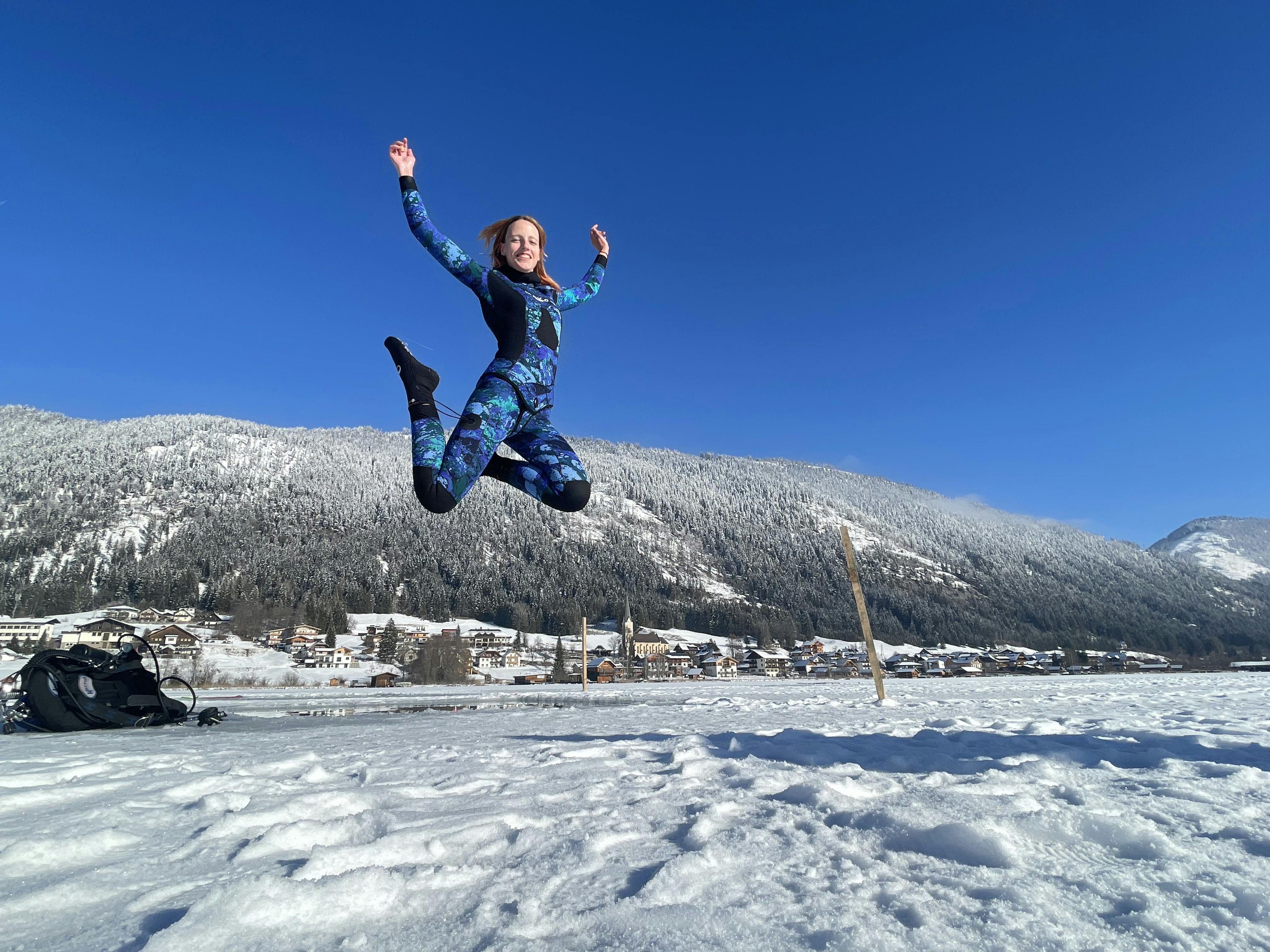
Another positive experience is the social factor- diving under the ice takes a lot of courage and determination, not only in freediving but in real life. With self-reflection sharing these beautiful moments together, I express gratitude for being surrounded by all these individuals who are not afraid of taking the breaks off from what truly drives them in their life. Thanks to Nik and other freediver experts the overall experience of the ice diving event was exceptional and memorable.
The support from the women freedivers gave me the strength and confidence. Thanks to the two committed freedivers- both Andreas- for motivating me and explaining how their experience was from the previous years, and what it takes to do the extreme sports for the very first time! I got inspired by the mermaid bikini performance and convinced myself- if she could do it, I could handle it too!
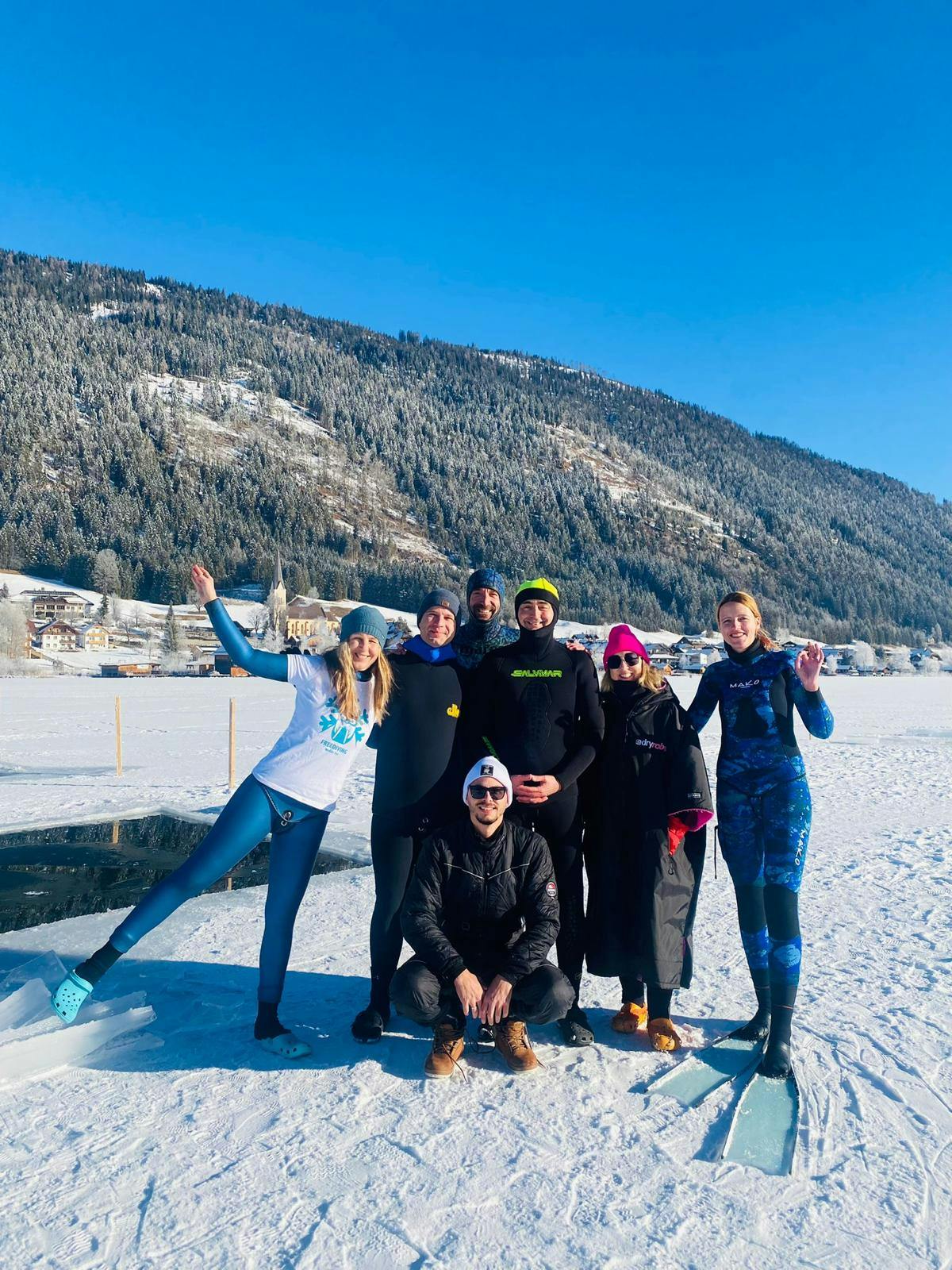
Prolonged whole body immersion in cold water, physiology
To characterize metabolic and hormonal responses during prolonged whole body immersion the studies have proven that immersion in cold water has significant impact on health.
Cold exposure in water increases the production of adiponectin in adipose tissue through the process of thermogenesis and is seen as a positive health effect. It plays an important role in protecting against insulin resistance, diabetes, atherosclerosis and other age-related diseases. [2]
A greater than threefold post immersion increase occurs in norepinephrine (NE). There are significant increases in triiodothyronine (T3) uptake and epinephrine, but no change in T3, thyroxine, thyrotropic hormone, and dopamine. Post immersion free fatty acid levels increase 409% from pre immersion levels; glucose levels decline, and lactate increases significantly. Only changes in NE correlates significantly with changes in rectal temperature.
In summary, when subjects are immersed in cold water for prolonged periods, with a slow rate of body cooling afforded by thermal protection and intermittent exercise, hormonal and metabolic changes occur that are similar in direction and magnitude to short-duration unprotected exposures. [3]
Ecotourism- sustainable travel to natural areas of Carinthia
The Weissensee is a lake in Carinthia at the foot of the Gailtal Alps north of Hermagor. It lies at 930 m above sea level, is 11.6 kilometers long; at its widest point it measures 900 meters, at its deepest 99 meters. Only a third of its 23-kilometer-long bank is built on, the rest is under nature and landscape protection.
The Weissensee has been known for its lake trout since the Middle Ages; in modern times, artificial stocking with other fish species such as perch, carp or pike has increased its attractiveness as a fishing water. However, due to the pressure of competition, some original species such as gudgeon or minnow are extinct.
The lake is considered to be good fishing waters due to its excellent water quality. With visibility depths of up to 6 meters and a water quality that comes close to that of drinking water, it brings an ideal site conditions for swimming and diving. To maintain the water quality, the use of internal combustion engines- exclusively liner shipping, police, water rescue, agriculture and forestry is not permitted on the lake. Protected landscape areas guarantee untroubled fishing, and for non-fishermen, the underwater world of the Weissensee is captivating as much. Five informative display boards along the promenade between Praditz and Techendorf give an overview of existing fish species, their habitats and protection in the lake ecosystem.
The lake is surrounded by a network of hiking and mountain bike trails of all levels of difficulty, several hundred kilometers long. Some mountain peaks (Latschur in the north, Golz in the south, Reisskofel in the west) can be reached from the lake via managed alpine pastures and huts. Camping is possible on the east bank near Stockenboi and on the west bank in Techendorf and Oberdorf.
In winter, with an ice sheet up to 58 centimeters thick, between December and March of around 80 days, the lake offers the largest ice surface in the Alps, which has been used for tourism since the late 1960s. Ice skating marathons have been held on the natural ice rink in January since 1989.
Nature’s Play of Colors- an experience for all
The state of Carinthia in southern Austria has recognized that a barrier-free design of the environment is also immensely important in tourism in order to enable everyone to have a carefree holiday and has established tourist businesses such as accommodation and gastronomy nationwide under the motto “Tourism for EVERYONE” which supports the development of a barrier-free access.
The project “Nature experience for EVERYONE” a.k.a. “Natueleben fur ALLE”, enables people of all ages with and without handicap a barrier-free experience of nature across Carinthia, 10 barrier-free infrastructures created in protected areas which are certified by ÖZIV. [4]
Global warming from Weissensee to Antarctica
While planning our next trip to Antarctica with divers from Weissensee, I would like to address the Global concerns that have been raised to prioritize areas to maximize the likelihood of ensuring the long-term conservation of aquatic ecosystems and biodiversity. The absence of systematic and representative protection is particularly acute for inland aquatic ecosystems, which support a disproportionate amount of inland biodiversity, such as Polar regions and protection of the Antarctic environment.
The Antarctic Peninsula (AP) region has been subjected to some of the most rapid climate warming on Earth during the 20th and 21st centuries, with an increase of more than five times the global mean (0.6 ± 0.2°C during the 20th century; Turner et al. Reference Turner, Maksym, Phillips, Marshall and Meredith2013).
Significant and rapid changes in sea-ice extent and drift in recent decades, or the reshaping biodiversity with ongoing climate change in the regions has occurred simultaneously with the intensification of human activities due to increases in scientific research and tourism that impose physical, chemical and biological burdens on the local environment.
The Tipping Point: How do small things make a big difference?
These measured (and extrapolated) warming trends in air temperature at the sub-Antarctic islands are impacting landscape and ecosystem processes. The further accelerated demise of glacial ice from those islands that still have it, due to either the increase in air temperature and the decrease in snow accumulation, means that the cryosphere is fast approaching an irreversible tipping point in the sub-Antarctic.
Warmer air temperatures will also modify ground thermal dynamics, which could impact the frequency and magnitude of needle ice growth, the freezing depths of both diurnal and seasonal frost and sediment movement and cycling. Needle ice formation is a very important diurnal soil frost process across most islands, impacting several keystone species and small-scale geomorphic processes in the fellfield habitat.
Transported propagules of invasive plant species have been shown to have increased rates of establishment and range expansion in the terrestrial habitats of the sub-Antarctic. Invasive vertebrates pose a significant risk to the ecology of sub-Antarctic islands, as shown by the impacts of the mice currently existing on Marion Island on ecosystem structure and functioning and on the predation on seabirds. Under an increasingly warming climate, the risk posed by invasive species to the ecology of the sub-Antarctic islands is predicted to intensify. The effective implementation of biosecurity measures for the sub-Antarctic islands is becoming progressively more crucial.
Environmental Protection adoption in Antarctic Peninsula
The effective use of conservation tools are made available through international agreements important for the current and future management and protection of the continent’s biodiversity and ecosystem values. Since the entry into force of the Antarctic Treaty in 1961, the protection of the Antarctic environment has partially ensured adoption of the Protocol on Environmental Protection to the Antarctic Treaty which began in 1998.
The Protocol provides for the comprehensive protection of the Antarctic environment and designates Antarctica as a ‘natural reserve, devoted to peace and science’. Annex II to the Protocol concerns the ‘Conservation of Antarctic Fauna and Flora’ and prohibits harmful interference by Parties to ensure that ‘the diversity of species, as well as the habitats essential to their existence, and the balance of the ecological systems existing within the Antarctic Treaty area are maintained’.
Conservation of Antarctic values
Annex V to the Protocol (which entered into force in 2002) is the current mechanism providing for the designation of Antarctic Specially Protected Areas (ASPAs), the purpose of which is to protect areas with outstanding environmental, scientific, historical, wilderness or aesthetic values or planned or ongoing scientific research (Article 3.1 of Annex V) within a systematic environmental-geographical framework.
The values listed in Annex V are:
a) areas kept inviolate from human interference so that future comparisons may be possible with localities that have been affected by human activities;
b) representative examples of major terrestrial, including glacial and aquatic, ecosystems and marine ecosystems;
c) areas with important or unusual assemblages of species, including major colonies of breeding native birds or mammals;
d) the type locality or only known habitat of any species;
e) areas of particular interest to ongoing or planned scientific research;
f) examples of outstanding geological, glaciological or geomorphological features;
g) areas of outstanding aesthetic and wilderness value;
h)sites or monuments of recognised historic value; and
i) such other areas as may be appropriate to protect the values identified in Article 3.1 (as detailed above).
Ineffectiveness of the Protocol mechanisms
In recent years the concerns have been raised over the implementation of the Protocol and of the current protected area system. Issues raised include that of spatial bias in the designation of ASPAs towards proximity to national research stations and to a subset of research interests specifically warned against bias towards easily detectable and charismatic species and suggested that systematic processes to prioritize area protection using the best available data will maximize the likelihood of ensuring long-term protection and conservation of Antarctic biodiversity. [5]
Seasonal shifts in microbial diversity in the lakes
Based on the publications from scientists carrying out research into the role of open water dynamics on climate change research, and our own observations on the physical environments varying in relative importance at local and regional scales, the question remains- am I educated enough about biological conservation not to impose burden to the local environment?
For example, climate (temperature and precipitation) tends to be an important driver of ecological processes at broad spatial scales, while other biotic and abiotic interactions become more important at fine spatial scales (e.g. Aerts Reference Aerts1997). To preserve biodiversity in a changing world, there is a need to understand the drivers of biological abundance and community composition across scales, including both alpha diversity-diversity within a location, and beta diversity- dissimilarity in species composition across locations. [6]
The joys of returning to “in-person” in an age of travel judgment
How do we justify going anywhere at all? Perhaps the simple answer is to recognize that anything we do, or don’t do, has costs and benefits. As emphasized by Dana Bergstrom in her memorable and motivating Biology Symposium plenary, if we do choose to travel, we have the responsibility and ability to maximize whatever the benefits are from that travel, most obviously by combining multiple ‘events’ to maximize our contribution or learning, contributing where practical to ‘hybrid’ events in order to maximize their reach and using all means at our disposal to ensure our messages get out to wider audiences.[7]
This form of storytelling is changing how we communicate the excitement of remote science to a wide audience. Stories about past exploration can teach us about perseverance - and that from failure can come great achievements – but they can also help us learn about how to move forward into a more equitable future. Stories about modern expeditions to ‘far-away’ places are inspiring. And stories about science can help us make sense of who we are, our universe and our place within it. [8]
Our role in environmental system
The Earth System components make a dynamic and interconnected system that has a significant impact on Earth’s climate and various physical processes. Understanding the science and physics of the cryosphere is essential for addressing climate change, sea level rise, and the broader implications for the planet’s environmental systems. During our dive trip we were only laughing about our next freediving trip to Antarctica. It brought us awareness on similar, and also very difficult obstacles we wouldn’t able to overcome due to the global warming impact on ecosystems that are becoming increasingly noticeable. The ice diving was a strongest dive experience that reminded us that we are part of this ecosystem and a global movement.
Thanks to the Marcus for diving with us and capturing the best freediving moments; Nik Linder for organization, dive safety, setup, training and supervision, Barbara and hotel Kolbitsch am Weissensee for the warm welcoming, and dive center Yachtdiver Weissensee for technical support!
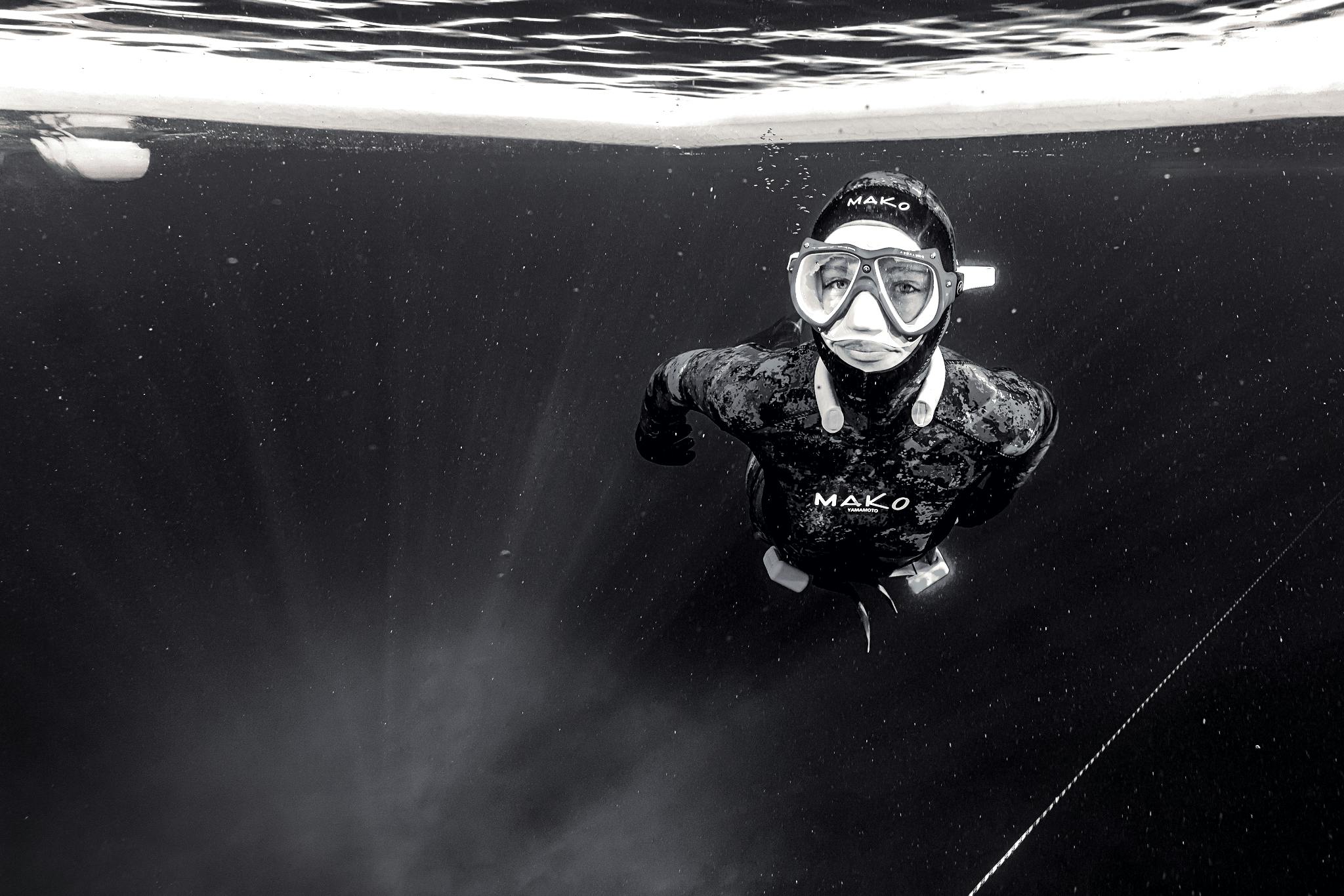
References:
-
Earth and Planetary Sciences, Hoar Frost https://www.sciencedirect.com/topics/earth-and-planetary-sciences/hoar-frost
-
[53] Atzmon G, Pollin TI, Crandall J, et al. Adiponectin levels and genotype: a potential regulator of life span in humans. J Gerontol A Biol Sci Med Sci. 2008;63(5):447–453. https://pubmed.ncbi.nlm.nih.gov/18511746
-
Prolonged whole body immersion in cold water https://pubmed.ncbi.nlm.nih.gov/2321318/
-
Kärnten – Eine Vorzeigeregion für barrierefreies Reisen, https://1001reisetraeume.de/kaernten-eine-vorzeigeregion-fuer-barrierefreies-reisen/
-
Hawes I, Howard-Williams C, Gilbert N, Hughes KA, Convey P, Quesada A. The need for increased protection of Antarctica’s inland waters. Antarctic Science. 2023;35(2):64-88. doi:10.1017/S0954102022000463
-
Siegert, M., Bentley, M., Atkinson, A., Bracegirdle, T., Convey, P., Davies, B., et al 2023. Antarctic extreme events. Frontiers in Environmental Science, 11, 10.3389/fenvs.2023.1229283.CrossRefGoogle Scholar Convey P. The joys of returning to in-person conferences - in an age of travel judgment. Antarctic Science. 2023;35(5):317-318. doi:10.1017/S0954102023000299
-
(Usher & Booth Reference Usher and Booth1984, Nemergut et al. Reference Nemergut, Schmidt, Fukami, O’Neill, Bilinski and Stanish2013, Danis et al. Reference Danis, Van de Putte, Convey, Griffiths, Linse and Murray2020, González-Caro et al. Reference González-Caro, Duivenvoorden, Balslev, Cavelier, Grández and Macía2021)
-
Ball BA, Convey P, Feeser KL, Nielsen UN, Van Horn D. Habitat severity characteristics structure soil communities at regional and local spatial scales along the Antarctica Peninsula. Antarctic Science. 2023;35(2):103-119. doi:10.1017/S0954102023000019